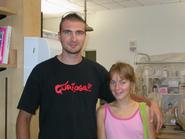
The new Science Center has brought many joys to students and professors alike. But while the center's impressive architecture certainly warrants appreciation, the resident collection of new "science toys" has stolen the attention of the inhabitants. Heather Michael '07 and Nikola Banishki '07, for instance, perk up when they talk about the new DNA-sequencing machine.
In fact, their task this summer is to play with the sequencer – to "test its capabilities and learn its secrets." Thanks to a grant from Li-Cor Biosciences, Banishki, Michael, and their "fellow Hamilton science geeks" will join a privileged minority of undergraduate research students who have access to such a progressive tool.
Michael had originally planned to spend her summer working on samples collected from the newly-exposed sea floor beneath a portion of the Antarctic Larsen B ice shelf that collapsed in 2002. She had hoped to use the new DNA sequencer to genetically characterize the sea-floor fungal community with the ultimate goal of constructing a phylogenetic tree (or tree of ancestry) based on this genetic analysis. However, due to complications with sample collection during the expedition, Michael did not receive her samples.
She decided, instead, to join Banishki and his project advisor, Assistant Professor of Biology Michael McCormick, who were taking samples from the local Green Lake. They would then use these samples to test out the protocols of DNA sequencing and tree-building. In geological terms, Green Lake is a meromictic lake— its waters do not experience seasonal turn-over or mixing. As a result, there are two separate layers to the lake separated by a band called a chemocline. The top 18 feet are an aerobic environment (the organisms metabolize oxygen) and the lower level is an anaerobic environment (the organisms present do not metabolize oxygen).
Michael and Banishki are taking samples from the first 25 meters of Green Lake. They use a machine built by Banishki for the purpose. He explains that it is a "big tube with syringes" which can be inserted into the water and then suck in samples from different depths without much disturbing the water. They take a sample every one meter or so in the hopes of being able to observe how the ecological diversity differs above, at, and below the chemocline.
Where Michael focuses on the fungal diversity, Banishki will characterize the bacteria and archea in the lake. The goal of the project, he explains, is simply to "see what's out there." Taking the samples is quite difficult, Michael adds. The team's first set of samples was not entirely accurate and after some machine adjustment, they returned to take more samples, a trip which Banishki feels was "very successful."
This is Michael's third summer of research at Hamilton (her previous research has been in computational chemistry and ecology). Studying Green Lake as a second choice, Michael enjoys her research: "I'm a lot more independent," she says. "Nobody has really done this before," referring both to the lack of fungal diversity literature available and the new protocols the entire department is learning to use. "It's more than just a canned bio lab…there's no instruction sheet. I guess that's my job this summer: to outline the future instruction sheet!" She is planning to extend this summer's work on fungal diversity into her senior thesis.
Michael is an EMT and a biology lab TA. She does peer tutoring and works at the quantitative literacy center but is not limited to numbers: she has just returned from Belize, where she participated in an archaeology program. She is a native of Red Hook, N.Y. and advised in this project by Professor of Biology Jinnie Garrett.
Banishki, a native of Bulgaria, also returns for his third summer (he has previously worked in computational chemistry). He hopes to go to medical school or graduate school for design pharmacy or bio-chemistry. As a biochemistry and comparative literature major, Banishki tries to keep things balanced as much as his lab partner. "I use humanities to get away from science and science to get away from humanities." He will captain the crew team this year and has been a member since his first year in the college. He is also an R.A. and runs a radio show. This project, begun because he was "more interested in living science things," will form the basis of his senior thesis.
-Lisbeth Redfield
